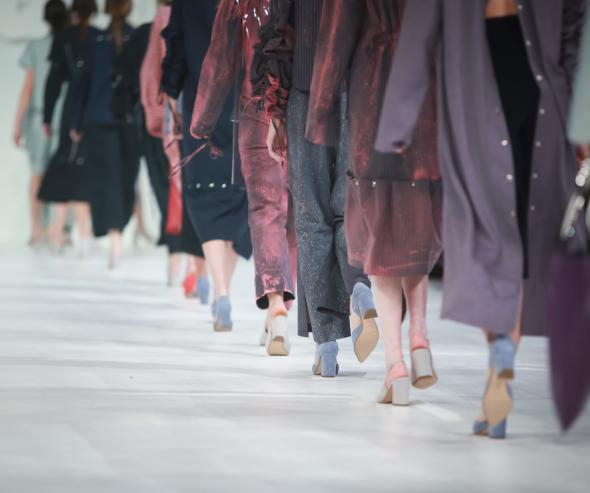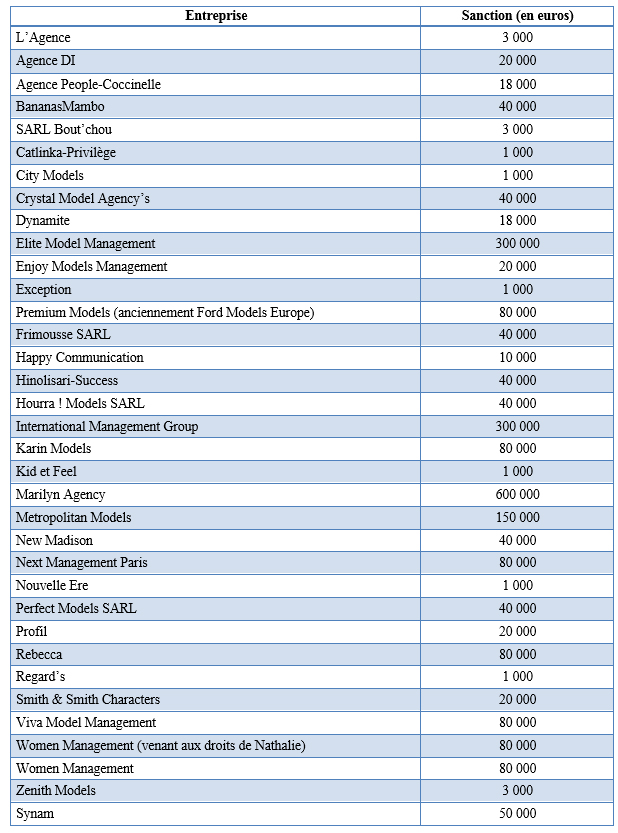29 September 2016 : Modelling sector

The Autorité fines for anticompetitive agreement the modelling sector’s main professional union and 37 modelling agencies
| In brief The Autorité de la concurrence today issues a decision under which it fines the main professional union of modelling agencies, the SYNAM, for having, between 2000 and 2010, drawn up and distributed pricing schedules as a guide to modelling agencies’ commercial policy. Advertisers and couture houses could refer to these schedules when setting prices for filming, advertising photos and catwalk shows. 37 modelling agencies, representing almost the entire market turnover, are also fined for having participated in statutory meetings on union pricing schedules between 2009 and 2010. |
Modelling agencies and their services
Modelling agencies are responsible for recruiting and training models as well as promoting them (via "books"), in particular to fashion magazines and advertising agencies, as well as haute-couture and ready-to-wear fashion houses. They find them contracts and negotiate their services with advertisers (Renault, Peugeot, Orange, Citroën, Leclerc, etc.), wishing to use the services of models in their advertising campaigns. Agencies can also contract with communication agencies or couture houses (Versace, Christian Dior, Chanel, etc.) regarding presentations of their collections at catwalk shows.
Agencies differ hugely in terms of their reputation, territorial coverage, the type of model represented (exclusively men or women, both, children, actors) and the services provided (advertising photos and films, multi-activity agencies, etc.). The agencies Elite, Marilyn, IMG, Viva ou Next are among the best-known in the sector.
Pricing schedules were drawn up and distributed every year by the professional union
Pricing schedules were drawn up and distributed by the professional union shortly after the obligatory annual negotiations on models’ minimum salaries and were classified (by type of service - photos, filming, catwalk, media - and in accordance with the model’s reputation) as per the collective agreement.
The union was ambiguous as to the “official” nature of these pricing schedules, which not only covered minimum salary, but also established the total price that clients were invoiced for modelling services, with variations of up to three times minimum salary. Prices not only included the model’s remuneration, but also the agency’s margin.
The schedules were published in early January and distributed to union members by letter, email and on its website. They applied throughout the following calendar year. This practice took place from 2000 to 2010.
The agencies participated in meetings during which they discussed the drawing up, distribution and application of the union pricing schedules
Between 2009 and 2010, 37 agencies, including sectoral leaders (Elite, Marilyn, IMG, Viva,…), representing almost the whole market, took part in statutory meetings during which they voted on increasing union prices and/or discussed a rule regarding the ban on distributing their own pricing schedules.
The pricing schedules were then used as a reference for negotiations with clients. In the context of Fashion Weeks, use of these schedules was virtually systematic with little or no room for negotiation.
Practices which distorted the starting point for negotiations between modelling agencies and their clients and supported price alignment
By acting above and beyond its primary task of providing information, advice and the defence of its members’ professional interests, the union caused harm to the commercial autonomy of modelling agencies by price fixing and reduced competition on the market for the services provided by modelling agencies to their clients. By participating in the drawing up, distribution and, in some cases, application of pricing schedules, agencies distorted the basis for commercial negotiations and created obstacles to competition to the detriment of their clients.
The pricing schedules therefore supported price alignment, as demonstrated by the statements made by several of the agencies: "the agencies all charge the same commission rates and same invoice amounts." or "We charge the rates that everyone charges, namely the rates distributed by the SYNAM."
The fines
In total, 2 381 000 euros in fines have been pronounced.
In calculating them, the Autorité de la concurrence particularly took into account the seriousness of the practices and the damage caused to the economy. Finally, the Autorité took into account the financial difficulties encountered by several agencies, granting 3 agencies who did not contest the findings a 10% reduction in their fines.

> See full text of decision n° 16-D-20 du 29 septembre 2016 concerning practices in sector of services provided by model agencies
> Press Contact :
Aurore Giovannini / Tel : 01 55 04 01 81 / Mel

